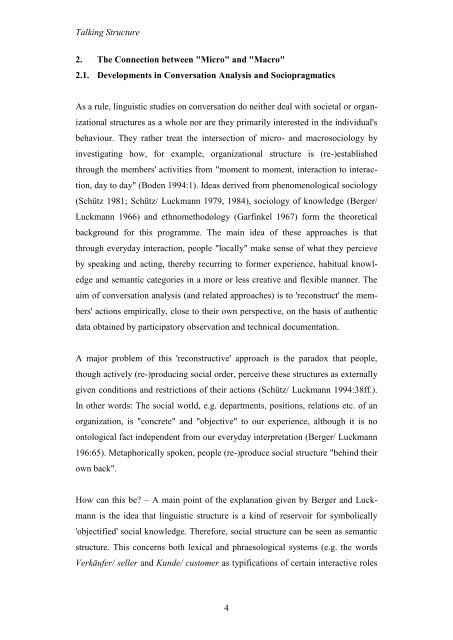In organisation theory, bridging the gap between „micro“ and „macro ...
In organisation theory, bridging the gap between „micro“ and „macro ...
In organisation theory, bridging the gap between „micro“ and „macro ...
Create successful ePaper yourself
Turn your PDF publications into a flip-book with our unique Google optimized e-Paper software.
Talking Structure<br />
2. The Connection <strong>between</strong> "Micro" <strong>and</strong> "Macro"<br />
2.1. Developments in Conversation Analysis <strong>and</strong> Sociopragmatics<br />
As a rule, linguistic studies on conversation do nei<strong>the</strong>r deal with societal or organ-<br />
izational structures as a whole nor are <strong>the</strong>y primarily interested in <strong>the</strong> individual's<br />
behaviour. They ra<strong>the</strong>r treat <strong>the</strong> intersection of micro- <strong>and</strong> macrosociology by<br />
investigating how, for example, organizational structure is (re-)established<br />
through <strong>the</strong> members' activities from "moment to moment, interaction to interac-<br />
tion, day to day" (Boden 1994:1). Ideas derived from phenomenological sociology<br />
(Schütz 1981; Schütz/ Luckmann 1979, 1984), sociology of knowledge (Berger/<br />
Luckmann 1966) <strong>and</strong> ethnomethodology (Garfinkel 1967) form <strong>the</strong> <strong>the</strong>oretical<br />
background for this programme. The main idea of <strong>the</strong>se approaches is that<br />
through everyday interaction, people "locally" make sense of what <strong>the</strong>y percieve<br />
by speaking <strong>and</strong> acting, <strong>the</strong>reby recurring to former experience, habitual knowl-<br />
edge <strong>and</strong> semantic categories in a more or less creative <strong>and</strong> flexible manner. The<br />
aim of conversation analysis (<strong>and</strong> related approaches) is to 'reconstruct' <strong>the</strong> mem-<br />
bers' actions empirically, close to <strong>the</strong>ir own perspective, on <strong>the</strong> basis of au<strong>the</strong>ntic<br />
data obtained by participatory observation <strong>and</strong> technical documentation.<br />
A major problem of this 'reconstructive' approach is <strong>the</strong> paradox that people,<br />
though actively (re-)producing social order, perceive <strong>the</strong>se structures as externally<br />
given conditions <strong>and</strong> restrictions of <strong>the</strong>ir actions (Schütz/ Luckmann 1994:38ff.).<br />
<strong>In</strong> o<strong>the</strong>r words: The social world, e.g. departments, positions, relations etc. of an<br />
organization, is "concrete" <strong>and</strong> "objective" to our experience, although it is no<br />
ontological fact independent from our everyday interpretation (Berger/ Luckmann<br />
196:65). Metaphorically spoken, people (re-)produce social structure "behind <strong>the</strong>ir<br />
own back".<br />
How can this be? – A main point of <strong>the</strong> explanation given by Berger <strong>and</strong> Luck-<br />
mann is <strong>the</strong> idea that linguistic structure is a kind of reservoir for symbolically<br />
'objectified' social knowledge. Therefore, social structure can be seen as semantic<br />
structure. This concerns both lexical <strong>and</strong> phraesological systems (e.g. <strong>the</strong> words<br />
Verkäufer/ seller <strong>and</strong> Kunde/ customer as typifications of certain interactive roles<br />
4














